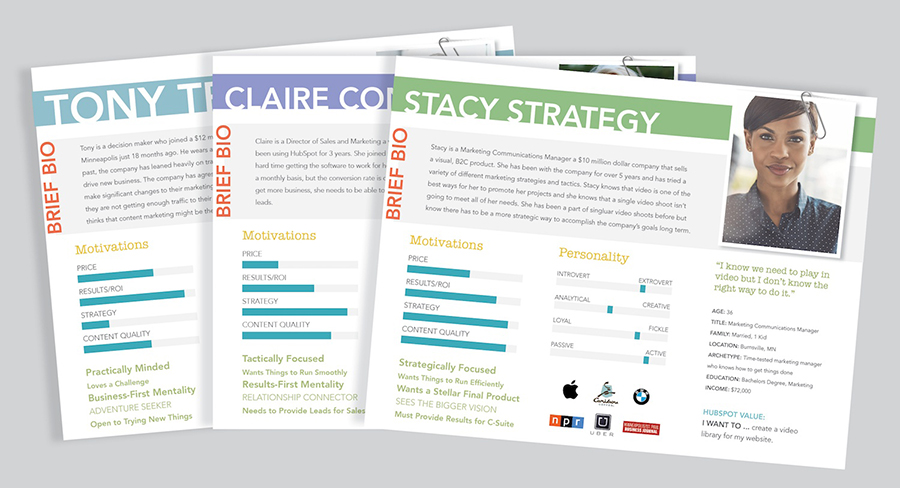One Dangerous Mistake is Preventing Successful Buyer Persona Development
I see it all the time. Whether it’s a new HubSpot portal, a PDF document, or just in conversation, there seems to be one, universally dangerous...
4 min read
 Kevin Page
:
November 27, 2017
Kevin Page
:
November 27, 2017
A lot of marketers using HubSpot believe they will have more leads coming in the door than they can handle simply by subscribing to the software. Unfortunately, that’s not the case.
HubSpot is ultimately a tool, or even better, a toolbox. Much like a contractor would have a toolbox with all the equipment necessary to complete a project, HubSpot provides you with the equipment to execute your marketing strategy and drive desired results for your business.
For the contractor, the success of the project is much more dependent on the development of the blueprint as opposed to the physical tools available. And marketing is no different.
If you aren't getting the results you want from your campaigns, it may be because of a strategy issue. Here are 6 signs that might be you:
This is easily the best place to start if you’re struggling to see the results you’re seeking within HubSpot. Have you created a content marketing strategy? In other words, have you established thoughtful marketing campaigns made up of specific tactics with attainable goals?
If you haven’t, halt your marketing activities right now and grab a whiteboard.
When you’re standing at your whiteboard, start by writing down your goals. What do you hope to accomplish with the tools you have access to in HubSpot or your marketing in general? After you identify goals, examine your current marketing and sales processes to identify gaps and prioritize your campaigns.
You can't do everything at once, so don’t get overwhelmed if you discover several broken elements within your processes. Instead, prioritize by the most important to your business’ success and construct strategic campaigns to fill those gaps one at a time.
STAY FOCUSED. It helps to have your strategy written down on paper. We've created this content marketing strategy template that can provide you with the framework to get started. Give yourself the permission to say no to new tasks that may come across your desk, and stay focused on the tasks that are essential to the success of your business.
If you’re struggling to drive results through the content you’re distributing, there’s most likely an issue with your messaging. If you have a blog, what’s your process for creating and producing new topics?
Let me guess, your company wants to write a post about a new product offering? Or, maybe your organization just made an acquisition and you want to share this news with your audience?
I may not have nailed your exact blog “strategy” with those examples, however, most businesses get stuck developing content that shares the information THE COMPANY wants the audience to know.
Instead, companies should focus on sharing information THE AUDIENCE wants to learn about. Answer their questions, provide helpful information, and understand that your product or service may not always be the best solution for their problems.
You absolutely have to define your buyer personas to create a marketing strategy. There are no shortcuts here. If you don’t take the time to study and learn about your audience, how can you successfully create messaging that will draw their attention and motivate them to buy? The answer is, you can’t. You simply can’t.
What audience(s) are you targeting? What are they motivated/challenged by? How do they prefer to engage with marketing messages? How do they find information online? Do they like reading blog articles, receiving helpful info in emails, watching videos, reviewing infographics, etc.?
It's essential that you take the time to document buyer personas as well. After all, 71% of companies who exceed revenue and lead goals have documented personas vs. 37% who simply meet goals and 26% who miss them. If you haven't documented your personas, we've got an easy-to-use template to help you get started with that, as well.
What’s new in the world of SEO? How can I set up a Facebook ad campaign? What’s all the buzz about Facebook Messenger? How can I propel my content strategy to the next level?
These are examples of simple questions that I’ve invested a lot of time with to understand, develop a strategy for, and execute on. You have to force yourself to put in the work.
If you don't know where to start researching, then you probably aren't connected to enough marketing experts. Check out podcasts, live videos, webinars, and workshops from industry experts like Mari Smith, Neil Patel, Content Marketing Institute and blogs just like this one.
Bottom line: marketing activities require resources. There are so many companies that struggle to execute on their developed strategy due to the lack of allocated resources.
During budget/resource planning meetings, do your best to emphasize the importance of dedicating necessary resources to help your marketing strategy flourish. And, always plan that the development of campaigns will take more time than you anticipate.
Be realistic about what you will be able to accomplish with the team you have in place today. What strategies and tactics will you need to implement to grow? Does your team have the capacity to do any more work?
A lot of companies find that, in order to grow, they need outside help in some capacity. For some companies, that may come in the form of hiring a new member of their team. For other companies, that same budget might be best invested in partnering with an agency that specializes in that growth area.
HubSpot allows you to measure the results of virtually any marketing activity. All you have to do is analyze the data.

Look through emails, landing pages, forms, blog posts, traffic sources, contact records to locate your successes and failures. Then, make data-driven decisions to adjust current campaigns and/or create new ones.
Remember, HubSpot is just a toolbox. It doesn’t replace the role of human beings constructing a strategy, creating content, developing buyer personas, conducting research, distributing resources, and analyzing results.
So, if you’re not having success with HubSpot, start by exploring the gaps in your marketing strategy.
Hubspot, on its own, is not a magic magnet that will draw in all the perfectly qualified leads. However, it is a toolbox (and a really good one at that) to help you deploy your content marketing strategy in a way that can drive real results and help you meet your goals.
If you are struggling to make the HubSpot engine run, we'd love to chat. We are passionate about helping companies get the most out of their investment in marketing automation.

I see it all the time. Whether it’s a new HubSpot portal, a PDF document, or just in conversation, there seems to be one, universally dangerous...
![[REVIEW] HubSpot Content Marketing Certification](https://www.clubmarketing.com/hubfs/2021-clean/images/blog/ContentMarketing-1.jpg)
As a content marketer working on the HubSpot platform, I'm thrilled with the newly-created Content Marketing Certification. Why? Because it puts...

Whether you're on your first cup of coffee for the morning or pushing through the last half hour of the day, there's nothing quite like an...